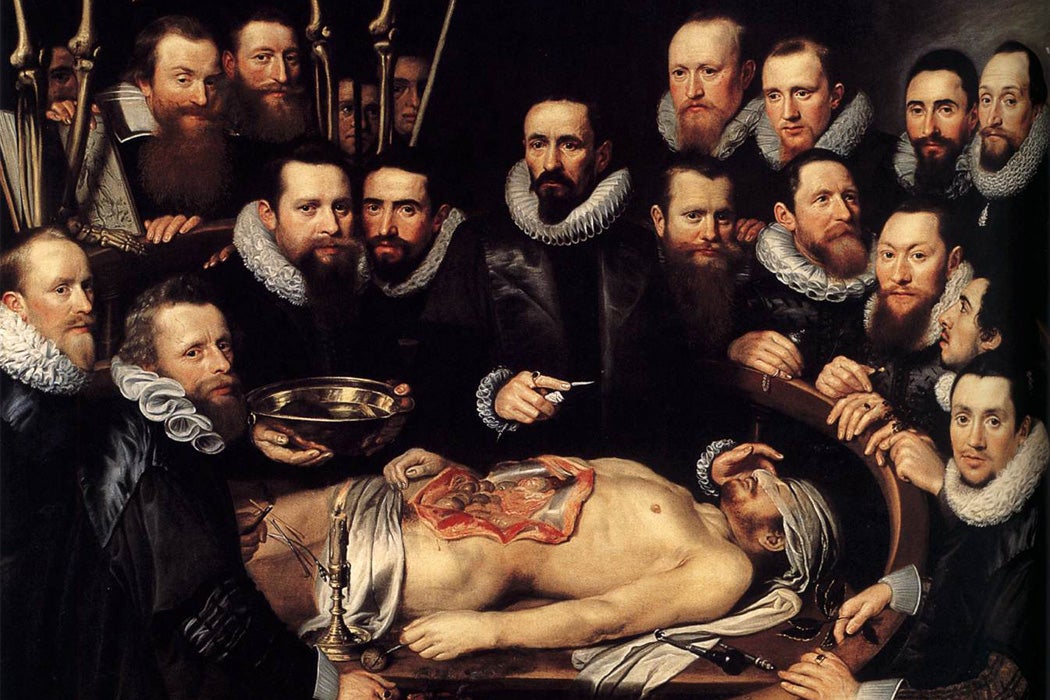Andreas Vesalius was an anatomist whose work revolutionized the study of the human body. He was also a grave robber. Students in tow, Vesalius snatched bodies from gibbets and forged keys to break into tombs. He negotiated with judges to turn life sentences into death sentences. Once the prisoners were executed, they could make their way to his dissection table.
Vesalius’ exploits were far from unusual, at least among Renaissance-era anatomists. Another account tells of how, after a peasant was murdered, scholars rushed to the scene of the crime in hopes of snagging the body. They were foiled: “the peasants having gathered there in good number did not let them take the body away,” and the scholars were forced to wait for a suitable corpse.
Luckily enough for the scholars, a man was executed a short time after and his body was given to them. As the account notes:
it should be remembered that the poor wretch had been condemned to prison for life, but that to satisfy the demands of the scholars, the cardinal legate overruled the decree that had already been passed, and had him condemned to death.
The sixteenth century has often been called “the century of anatomy.” The name comes not just from the scientific breakthroughs that attended the period, but from the overwhelming public interest in anatomy as a discipline. Crowds packed into anatomy theaters to witness public dissections. In Bologna, some audience members would even arrive wearing Carnival masks.
In the anatomy theater, candles flickered through the hall, the walls were hung with damask, and torches burned at the corpse’s head and feet. Skeletons were posed about the hall in “moral scenes,” meant to encourage the viewer to reflect on the transience of mortal life. At the same time, the dissections could be surprisingly rowdy affairs. The debates between rival scholars were lively, even heated, and the students were infamous for being unruly and disruptive.
At one point, the anatomy college in Padua even brought in a troupe of musicians to play throughout the dissection, lending an air of solemnity and reverence to the proceedings. Meanwhile, in a nearby chapel, masses were said for the soul of the person being dissected. Who were they? One of those unlucky prisoners who had been executed at the anatomist’s behest, or perhaps a poor unfortunate who died penniless in a hospital.
Before their eyes, the anatomist or the barber-surgeon would slice into the cadaver and explain how each system of the body revealed “the mysterious profundities of nature.” It wasn’t just the prurient appeal of seeing a gruesome spectacle that drew people to these events. According to the philosophers of the era, studying anatomy was not just an intellectual pursuit, but a moral duty. The intricate details of the body revealed the perfection of God’s design; studying anatomy allowed you to discover the divine workings of the universe within the microcosm of your flesh. This era saw the rise of “flap anatomies,” which used cutouts to reveal the successive strata of the human body. Readers could perform their own private dissection by peering through the layers of paper: naked flesh, muscles, tendons, and, finally, bare bones.
Get Our Newsletter
To Renaissance anatomists, the body was infused with moral meaning. This way of seeing the body has a long tradition in philosophical and religious thought. We can see it in the stories of incorruptible saints. The autopsy of Saint Chiara of Montefalco, for instance, revealed a heart full of miraculous trinkets: a crown of thorns, a whip and column, a rod and sponge, and even a set of tiny nails. Another saint carried a trio of stones in her heart, each inscribed with one of the members of the Holy Family. These features were the result of unusual piety and goodness, but sin might leave a physical trace in the body, too, as in the case of an infamous thief who, when dissected, was found to have a heart covered in hair.
Good and evil both were inscribed in the flesh, and anatomists taught people to “knowe thyself” by reading the books of their own bodies. Maybe it’s ironic that it was on the bodies of the community’s outcast fringe—executed convicts, the destitute—that anatomists practiced their interpretive art. There was an inherent cruelty in the spectacle of public dissection, and yet it was in these bodies that they uncovered the working of God’s hand—and the minute perfection of the human form.







